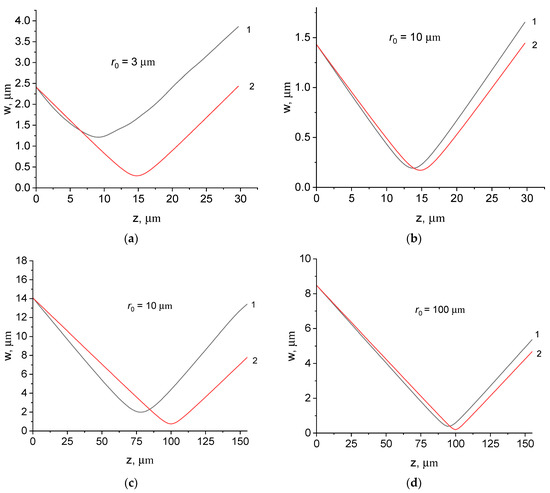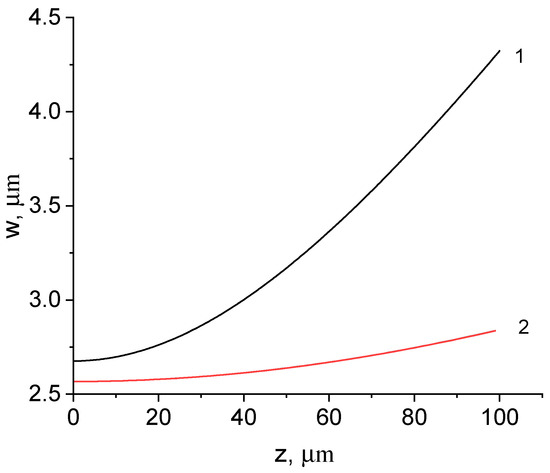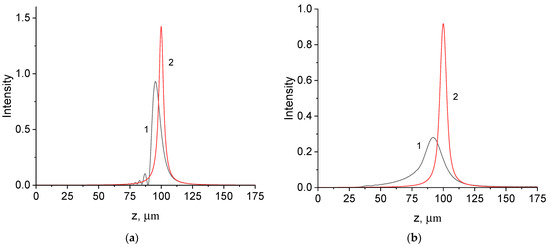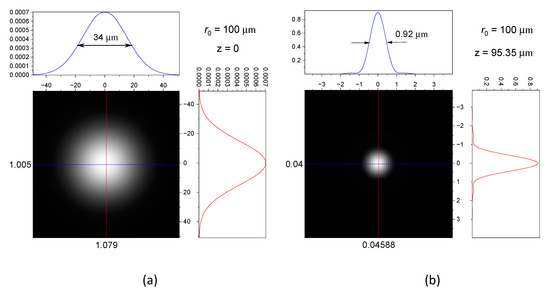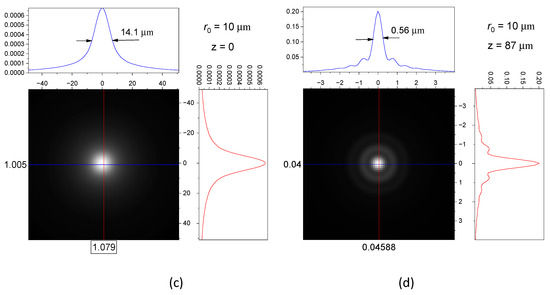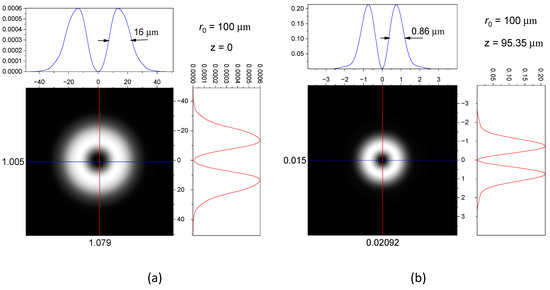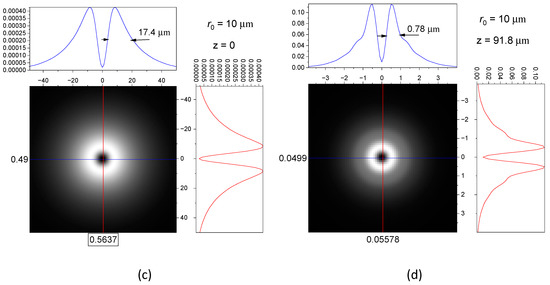Abstract
The nonparaxial focusing of partially coherent beams in free space has been studied using the coherent-state and coherent-mode decomposition methods. Analytical expressions for the width and angular divergence of partially coherent Gaussian Schell-model (GSM) beams have been obtained using the coherent-state method. It has been shown that the focusing plane is shifted in the opposite axial direction compared to the geometric focusing plane. The influence of the nonparaxiality and spatial coherence of Bessel-correlated vortex beams on the intensity distribution and displacement of the focus plane has been analyzed. It has been shown that the shift of the focus plane increases with a decrease in the coherence radius of the source. A smaller diffraction spread has been shown for partially coherent Bessel-correlated beams compared to GSM beams.
1. Introduction
The theory of the propagation of partially coherent waves in free space, as well as in inhomogeneous media, has now been developed quite fully [1,2,3,4,5]. Partially coherent sources can be used to overcome speckles in imaging systems and increase the signal-to-noise ratio in free-space optical communication, remote sensing, etc. Gaussian Schell-model (GSM) beams are familiar partially coherent sources which represent natural sources [1]. The properties of these beams were studied extensively until recently [6,7,8,9,10,11,12,13]. Partially coherent sources with specific propagation properties that lead to the formation of highly directional light beams were considered in the last two decades [14,15,16,17,18,19,20,21,22,23].
Tightly focused beams find important applications in optical data storage, microscopy, lithography, particle trapping, etc. The focusing of partially coherent GSM and Laguerre–Gaussian-correlated Schell-model beams was studied theoretically and experimentally [24,25,26,27,28,29,30]. The focusing properties of partially coherent beams with specific correlation functions were also investigated. In [31], the focusing of partially coherent Bessel–Gaussian beams was considered.
The focusing of a Gaussian beam in free space has been long and well studied using various methods, including analytical, asymptotic, and numerical approaches to integration. Usually, the problem is solved by calculation of diffraction integrals. However, the numerical simulation of the diffraction integrals is often time-consuming, and asymptotic methods have been developed for the calculations. A hybrid integration method combining numerical integration with asymptotic methods was proposed in [32]. In [33], the accuracy and computational savings of this hybrid technology were examined. Because of the existence of high-frequency oscillatory terms in the Rayleigh–Sommerfeld integral, the calculations are usually performed numerically on a submicron scale. Therefore, other time-saving modeling approaches are needed to facilitate the solution of the problem. Coherent-mode decomposition is a powerful method to simulate the propagation of partially coherent beams [34]. Another effective analytical method for studying the propagation and focusing of light beams is the quantum theoretical method of coherent states [35,36,37]. Density matrix formalism is useful for describing partially coherent sources in inhomogeneous media [38]. Most publications are devoted to the analysis of beam characteristics in paraxial approximation. However, it is well known that nonparaxial effects significantly influence the characteristics of a tightly focused beam [23,39,40,41,42,43,44].
While the focusing of Gaussian Schell-model beams is well studied [27,28,29,30], the nonparaxial focusing of Bessel-correlated beams has not been considered yet.
In this paper, the nonparaxial focusing and spreading of partially coherent Gaussian Schell-model and Bessel-correlated vortex beams in free space are investigated using the coherent-state and -mode decomposition methods. The influence of the effects of nonparaxiality on the field intensity distributions in the axial and radial directions near the focusing plane is analyzed.
2. Focusing of Gaussian Schell-Model Beam
The cross-spectral density (CSD) function of the Gaussian Schell-model beam is given by [1]
where a is the width of the beam, is the coherence length, , is the wavenumber, and is the wavefront curvature radius.
Below we consider the coherence function (1) in the coherent-state (CS) representation [35,36,37,38,39,40]:
The coherent state |α⟩ can be defined as an eigenfunction of the annihilation operator :
where
The explicit form of CS is given by a Gaussian beam function
where the complex eigenvalues determine the initial coordinates x0 of the center of the elementary beam and the angle of its inclination px0 = n0sinθ0 to the z-axis, n0 is the refractive index of the medium, and w0 is the elementary beam width.
The coherent states are the generating functions for the modes:
where is the Gauss–Hermite function.
Note that the Gauss–Hermite functions are the modal solutions of the Helmholtz equation describing the propagation of light in a planar graded-index waveguide with the refractive index in the transverse direction , where is the refractive index on the axis and is the gradient parameter.
The average of any beam value can be obtained using the following expression:
where , and Tr denotes the trace.
2.1. Beam Width
The average beam width is determined by
where ; , ;
where
Calculating the integral (6), we obtain
where , , , ,
Note that the third and fourth terms on the right side of Equation (9) are complex values. However, these two values are complex conjugate quantities, so the sum of these two values is a real quantity. If we put = 1 and , then the expressions obtained will describe the focusing of the light beam in free space.
Figure 1 shows the change in beam width during focusing for different coherence lengths of the incident beam at a wavefront curvature radius μm. Here and below on the graphs, the wavelength λ = 0.63 μm.
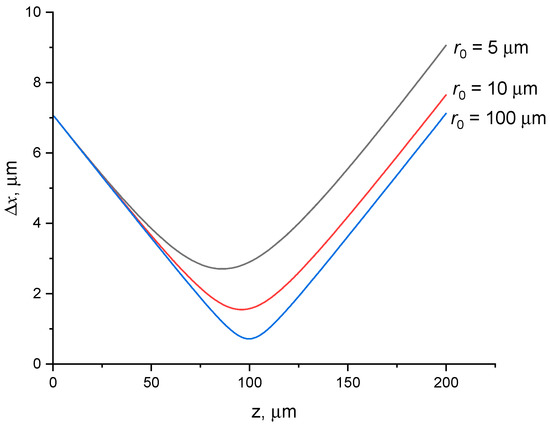
Figure 1.
Beam width change with propagation distance for different coherence lengths of the incident beam.
It follows that the beam width in the plane of focus increases with decreasing coherence length. The beam width is 0.72 μm for , 1.547 μm for , and 2.704 μm for . In addition, the focus plane shifts at , at , and at , which occurs due to the effects of nonparaxiality and coherence.
In Figure 2, the spreading of a partially coherent focused beam with (plane wavefront) is shown for different initial coherence lengths. In contrast to Figure 1, where beam spreading occurs due to the wavefront curvature and diffraction, here only diffraction affects the beam width.
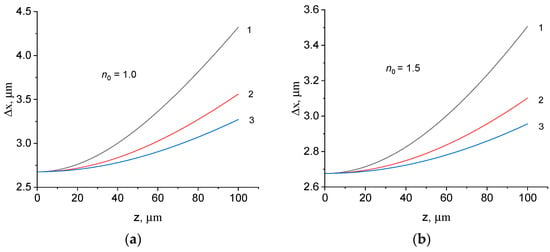
Figure 2.
Beam width change with distance for different coherence lengths of the incident beam: 1—; 2—; 3—. (a) ; (b) .
The beam width increases faster with distance with a shorter coherence length of the incident beam. In addition, the refractive index of the medium affects the spreading of the beam (Figure 2b). The spreading of the beam weakens with an increase in the refractive index of the medium.
2.2. Angular Divergence
The angular divergence of the partially coherent Gaussian Schell-model beam (1) in the initial plane z = 0 can be represented in the form
where is the beam radius, is the coherence radius, and is the wavefront curvature radius.
In Figure 3, the angular divergence dependence on the beam waist width is presented for different coherence lengths.
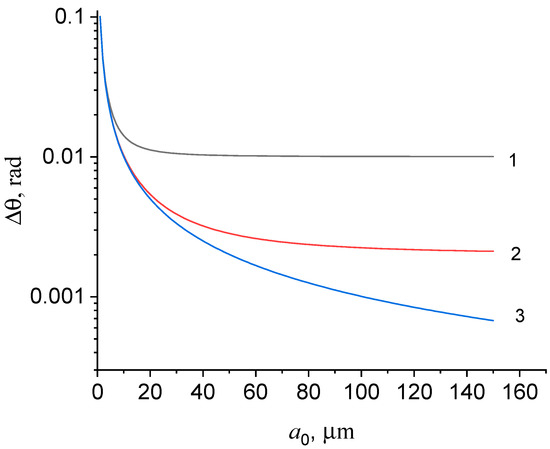
Figure 3.
Angular divergence as a function of beam waist width: 1—; 2—; 3—. .
It can be seen that the angular divergence of the GSM beam is higher for a source with less coherence.
The change in the angular divergence with the distance is determined by the formula
where ; .
Calculating the traces in (11), we obtain
2.3. Uncertainty Relationship
The threshold for the maximum focusing of the light is determined by the following uncertainty relationship:
where the angular divergence is given by (12).
Relationship (13) is valid for a beam with a flat wavefront. In the case of beams with a spherical wavefront, the following uncertainty relationship can be obtained [39,40]:
and because , , i.e., the minimum value of the wavefront curvature radius is diffraction-limited.
This indicates that the numerical aperture (convergence angle) is also diffraction-limited.
Relationship (14) can be obtained from the following Schrodinger–Robertson uncertainty relation [42]:
where , , ,
In Figure 4, the dependence of the uncertainty values on the propagation distance is shown.
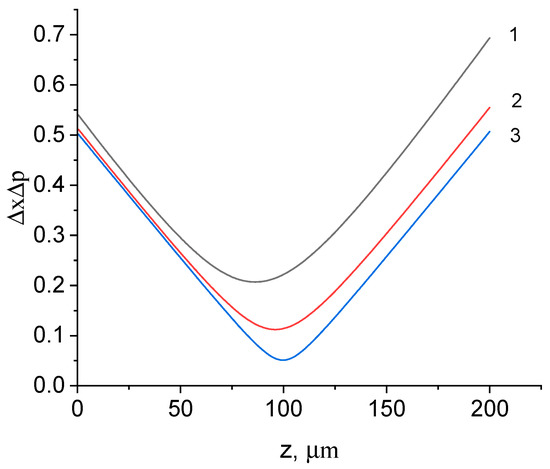
Figure 4.
The uncertainty value as function of distance for different coherence radii of the incident beam: 1—; 2—; 3—. .
The uncertainty changes with distance, taking a minimum value in the plane of focus.
4. Conclusions
Thus, the nonparaxial focusing of partially coherent Gaussian Schell-model and Bessel-correlated vortex beams in free space has been investigated using the coherent-state and the mode decomposition methods.
It is found that the average radii in the focusing plane increase with decreasing coherence radius. However, calculations of the intensity profiles show that bright spots and rings of smaller sizes can be obtained using the sources with low-coherence Bessel-correlated sources. The beam width estimated on the basis of the intensity distribution, i.e., the FWHM (full width at half maximum) value, shows a behavior different from that based on the calculation of the standard deviation. Indeed, the FWHM value of the focusing spot of a low-coherent light beam determined by the intensity distribution can be smaller than that of a coherent light beam. It is shown that the effect of shifting the focusing plane in the axial direction opposite to the geometric focusing plane is enhanced with a decrease in coherence.
It follows from the simulation results that the partially coherent Bessel-correlated beams have less spread than the Gaussian Schell-model beams. This preferred property can be useful in specific fields, especially in optical communication in free space.
Future research can be related to the consideration of focusing partially coherent and partially polarized vector beams [45]. Of practical interest is the consideration of structured vortex beams with spin angular momentum (SAM) and orbital angular momentum (OAM) [46,47,48], partially coherent accelerating beams [49], beams possessing self-healing abilities in a turbulent media [50], and spatiotemporal optical vortex beams [51].
In summary, the nonparaxial focusing of the GSM beam has been studied using the CS decomposition method. The nonparaxial focusing and spreading of a Bessel-correlated beam in free space were analyzed using the coherent-mode decomposition method. It is shown that partially coherent Bessel-correlated beams have a smaller spatial spread than GSM beams. The average spot size in the focusing plane increases with a decrease in the degree of coherence. However, the FWHM value of the focusing spot of a low-coherence light beam, determined by the intensity distribution, can be less than that of a coherent light beam. It is shown that the shift of the focusing plane increases with decreasing coherence.
The results obtained can be useful for microparticle trapping, transmitting information, optical visualization, and optical communication in free space.
Funding
This research was funded by the Ministry of Science and Higher Education of the Russian Federation under the State contract No. FFNS-2022-0009.
Institutional Review Board Statement
Not applicable.
Informed Consent Statement
Not applicable.
Data Availability Statement
Not applicable.
Conflicts of Interest
The author declares no conflict of interest.
References
- Wolf, E. Introduction to the Theory of Coherence and Polarization of Light; Cambridge University Press: Cambridge, UK, 2007. [Google Scholar]
- Mandel, L.; Wolf, E. Optical Coherence and Quantum Optics; Cambridge University Press: Cambridge, UK, 1995. [Google Scholar]
- Wolf, E. Unified theory of coherence and polarization of random electromagnetic beams. Phys. Lett. A 2003, 312, 263–267. [Google Scholar] [CrossRef]
- Tervo, J.; Setala, T.; Friberg, A.T. Theory of partially coherent electromagnetic fields in the space-frequency domain. J. Opt. Soc. Am. A 2004, 21, 2205–2215. [Google Scholar] [CrossRef]
- Korotkova, O.; Hoover, B.G.; Gamiz, V.L.; Wolf, E. Coherence and polarization properties of far fields generated by quasi-homogeneous planar electromagnetic sources. J. Opt. Soc. Am. A 2005, 22, 2547–2556. [Google Scholar] [CrossRef]
- Liu, Z.; Zeng, J.; Cai, Y. Review on vortex beams with low spatial coherence. Adv. Phys. 2019, 4, 1626766. [Google Scholar] [CrossRef]
- Zeng, J.; Lin, R.; Liu, X.; Zhao, C.; Cai, Y. Review on partially coherent vortex beams. Front. Optoelectron. 2019, 12, 229–248. [Google Scholar] [CrossRef]
- Dong, M.; Zhao, C.; Cai, Y.; Yang, Y. Partially coherent vortex beams: Fundamentals and applications. Sci. China Phys. Mech. Astron. 2021, 64, 224201. [Google Scholar] [CrossRef]
- Zhang, H.; Lu, X.; Wang, Z.; Konijnenberg, A.P.; Wang, H.; Zhao, C.; Cai, Y. Generation and Propagation of Partially Coherent Power-Exponent-Phase Vortex Beam. Front. Phys. 2021, 9, 781688. [Google Scholar] [CrossRef]
- Chen, Y.; Wang, F.; Cai, Y. Partially coherent light beam shaping via complex spatial coherence structure engineering. Adv. Phys. X 2022, 7, 2009742. [Google Scholar] [CrossRef]
- Krivoshlykov, S.G.; Petrov, N.I.; Sisakyan, I.N. Spatial coherence of optical fields in longitudinally inhomogeneous media with the square-law index profile. Sov. J. Quantum Electron. 1985, 15, 330–338. [Google Scholar] [CrossRef]
- Petrov, N.I.; Petrova, G.N. Diffraction of partially coherent light beams by micro-lens arrays. Opt. Express 2017, 25, 22545–22564. [Google Scholar] [CrossRef] [PubMed]
- Petrov, N.I. Holographic diffuser with controlled scattering indicatrix. Comp. Opt. 2017, 41, 831–836. [Google Scholar] [CrossRef]
- Gori, F.; Palma, C. Partially coherent sources which give rise to highly directional light beams. Opt. Commun. 1978, 27, 185–188. [Google Scholar] [CrossRef]
- Ponomarenko, S.A. A class of partially coherent beams carrying optical vortices. J. Opt. Soc. Am. A 2001, 18, 150–156. [Google Scholar] [CrossRef]
- Marasinghe, M.L.; Premaratne, M.; Paganin, D.M.; Alonso, M.A. Coherence vortices in Mie scattered nonparaxial partially coherent beams. Opt. Expr. 2012, 20, 2858–2875. [Google Scholar] [CrossRef]
- Alieva, T.; Rodrigo, J.A.; Camara, A.; Abramochkin, E. Partially coherent stable and spiral beams. J. Opt. Soc. Am. A 2013, 30, 2237–2243. [Google Scholar] [CrossRef] [PubMed]
- Ostrovsky, A.S.; García-García, J.; Rickenstorff-Parrao, C.; Olvera-Santamaria, M.A. Partially coherent diffraction-free vortex beams with a Bessel-mode structure. Opt. Lett. 2017, 42, 5182–5185. [Google Scholar] [CrossRef]
- Santamaría, M.A.O.; Garciapiña, J.L.R.; García, J.G.; Ostrovsky, A.S. Generation of a partially coherent secondary source with Bessel-mode vortex structure by liquid crystal spatial light modulator. Opt. Commun. 2019, 439, 312–316. [Google Scholar] [CrossRef]
- Chen, X.; Li, J.; Rafsanjani, S.M.H.; Korotkova, O. Synthesis of Im-Bessel correlated beams via coherent modes. Opt. Lett. 2018, 43, 3590–3593. [Google Scholar] [CrossRef]
- Xu, Z.; Li, X.; Liu, X.; Ponomarenko, S.A.; Cai, Y.; Liang, C. Vortex preserving statistical optical beams. Opt. Exp. 2020, 28, 8475–8483. [Google Scholar] [CrossRef]
- Ferlic, N.A.; van Iersel, M.; Davis, C.C. Simulation of Im-Bessel beam propagation through time-correlated atmospheric turbulence. Proc. SPIE 2021, 11834, 118340L. [Google Scholar]
- Petrov, N.I. Nonparaxial Propagation of Bessel Correlated Vortex Beams in Free Space. Micromachines 2023, 14, 38. [Google Scholar] [CrossRef]
- Fischer, D.G.; Visser, T.D. Spatial correlation properties of focused partially coherent light. J. Opt. Soc. Am. A 2004, 21, 2097–2102. [Google Scholar] [CrossRef]
- Foreman, M.R.; Torok, P. Focusing of spatially inhomogeneous partially coherent, partially polarized electromagnetic fields. J. Opt. Soc. Am. A 2009, 26, 2470–2479. [Google Scholar] [CrossRef]
- Chen, B.; Zhang, Z.; Pu, J. Tight focusing of partially coherent and circularly polarized vortex beams. J. Opt. Soc. Am A 2009, 26, 862–869. [Google Scholar] [CrossRef] [PubMed]
- Wang, F.; Zhu, S.; Cai, Y. Experimental study of the focusing properties of a Gaussian Schell-model vortex beam. Opt. Lett. 2011, 36, 3281–3283. [Google Scholar] [CrossRef] [PubMed]
- Xu, H.F.; Zhang, Z.; Qu, J.; Huang, W. The tight focusing properties of Laguerre–Gaussian-correlated Schell-model beams. J. Mod. Opt. 2016, 63, 1429–1437. [Google Scholar] [CrossRef]
- Ping, C.; Liang, C.H.; Wang, F.; Cai, Y.J. Radially polarized multi-Gaussian Schell-model beam and its tight focusing properties. Opt. Express 2017, 25, 32475–32490. [Google Scholar] [CrossRef]
- Lin, H.; Zhou, X.; Chen, Z.; Sasaki, O.; Li, Y.; Pu, J. Tight focusing properties of a circular partially coherent Gaussian beam. J. Opt. Soc. Am. A 2018, 35, 1974–1980. [Google Scholar] [CrossRef]
- Zhang, Z.; Pu, J.; Wang, X. Focusing of partially coherent Bessel–Gaussian beams through a high numerical-aperture objective. Opt. Lett. 2008, 33, 49–51. [Google Scholar] [CrossRef]
- Stamnes, J.J. Hybrid integration technique for efficient and accurate computation of diffraction integrals. J. Opt. Soc. Am. A 1989, 6, 1330–1342. [Google Scholar] [CrossRef]
- Eide, H.A.; Stamnes, J.J. Exact and approximate solutions for focusing of two-dimensional waves. J. Opt. Soc. Am. A 1998, 15, 1285–1319. [Google Scholar]
- Gori, F.; Santarsiero, M.; Simon, R.; Piquero, G.; Borghi, R.; Guattari, G. Coherent-mode decomposition of partially polarized, partially coherent sources. J. Opt. Soc. Am. A 2003, 20, 78–84. [Google Scholar] [CrossRef]
- Krivoshlykov, S.G.; Sisakyan, I.N. Coherent States and Light Propagation in Inhomogeneous Media. Sov. J. Quantum Electron. 1980, 10, 312–318. [Google Scholar] [CrossRef]
- Krivoshlykov, S.G.; Petrov, N.I.; Sisakyan, I.N. Correlated coherent states and propagation of arbitrary Gaussian beams in longitudinally homogeneous quadratic media exhibiting absorption or amplification. Sov. J. Quantum Electron. 1986, 16, 933–941. [Google Scholar] [CrossRef]
- Krivoshlykov, S.G.; Petrov, N.I.; Sisakyan, I.N. Mode excitation in waveguides with a quadratic refractive-index profile by partially coherent radiation sources. Sov. Tech. Phys. 1985, 30, 1031–1036. [Google Scholar]
- Krivoshlykov, S.G.; Petrov, N.I.; Sisakyan, I.N. Density-matrix formalism for partially coherent optical fields propagating in slightly inhomogeneous media. Opt. Quant. Electr. 1986, 18, 253–264. [Google Scholar] [CrossRef]
- Petrov, N.I. Nonparaxial focusing of wave beams in a graded-index medium. Rus. J. Quant. Electron. 1999, 29, 249–255. [Google Scholar] [CrossRef]
- Petrov, N.I. Focusing of beams into subwavelength area in an inhomogeneous medium. Opt. Exp. 2001, 9, 658–673. [Google Scholar] [CrossRef]
- Yuan, Y.; Du, S.; Dong, Y.; Wang, F.; Zhao, C.; Cai, Y. Nonparaxial propagation properties of a vector partially coherent dark hollow beam. J. Opt. Soc. Am. A 2013, 30, 1358–1372. [Google Scholar] [CrossRef]
- Petrov, N.I. Macroscopic quantum effects for classical light. Phys. Rev. A 2014, 90, 043814. [Google Scholar] [CrossRef]
- Petrov, N.I. Evanescent and propagating fields of a strongly focused beam. J. Opt. Soc. Am. A 2003, 20, 2385–2389. [Google Scholar] [CrossRef]
- Petrov, N.I. Reflection and transmission of strongly focused light beams at a dielectric interface. J. Mod. Opt. 2005, 52, 1545–1556. [Google Scholar] [CrossRef]
- Zhang, Z.; Fan, H.; Xu, H.F.; Qu, J.; Huang, W. Three-dimensional focus shaping of partially coherent circularly polarized vortex beams using a binary optic. J. Opt. 2015, 17, 065611. [Google Scholar] [CrossRef]
- Petrov, N.I. Depolarization of Light in Optical Fibers: Effects of Diffraction and Spin-Orbit Interaction. Fibers 2021, 9, 34. [Google Scholar] [CrossRef]
- Petrov, N.I. Depolarization of vector light beams on propagation in free space. Photonics 2022, 9, 162. [Google Scholar] [CrossRef]
- Li, H.; Ma, C.; Wang, J.; Tang, M.; Li, X. Spin-orbit Hall effect in the tight focusing of a radially polarized vortex beam. Opt. Exp. 2021, 29, 39419–39427. [Google Scholar] [CrossRef]
- Dev, V.; Reddy, A.N.K.; Ustinov, A.V.; Khonina, S.N.; Pal, V. Autofocusing and Self-Healing Properties of Aberration Laser Beams in a Turbulent Media. Phys. Rev. Appl. 2021, 16, 014061. [Google Scholar] [CrossRef]
- Zeng, Z.; Zhao, D. Partially coherent dual nonparaxial accelerating beams. Ann. Phys. 2020, 533, 2000438. [Google Scholar] [CrossRef]
- Hyde, M.W., IV; Korotkova, O.; Spencer, M.F. Partially coherent sources whose coherent modes are spatiotemporal optical vortex beams. J. Opt. 2023, 25, 035606. [Google Scholar] [CrossRef]
Disclaimer/Publisher’s Note: The statements, opinions and data contained in all publications are solely those of the individual author(s) and contributor(s) and not of MDPI and/or the editor(s). MDPI and/or the editor(s) disclaim responsibility for any injury to people or property resulting from any ideas, methods, instructions or products referred to in the content. |
© 2023 by the author. Licensee MDPI, Basel, Switzerland. This article is an open access article distributed under the terms and conditions of the Creative Commons Attribution (CC BY) license (https://creativecommons.org/licenses/by/4.0/).
